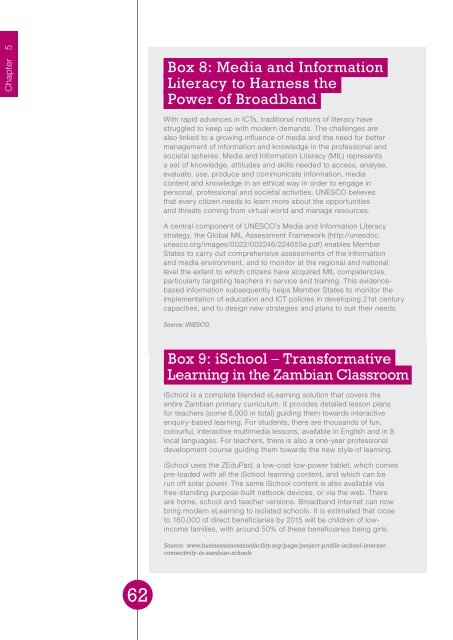DI8xz
DI8xz
DI8xz
Create successful ePaper yourself
Turn your PDF publications into a flip-book with our unique Google optimized e-Paper software.
Chapter 5Box 8: Media and InformationLiteracy to Harness thePower of BroadbandWith rapid advances in ICTs, traditional notions of literacy havestruggled to keep up with modern demands. The challenges arealso linked to a growing influence of media and the need for bettermanagement of information and knowledge in the professional andsocietal spheres. Media and Information Literacy (MIL) representsa set of knowledge, attitudes and skills needed to access, analyse,evaluate, use, produce and communicate information, mediacontent and knowledge in an ethical way in order to engage inpersonal, professional and societal activities. UNESCO believesthat every citizen needs to learn more about the opportunitiesand threats coming from virtual world and manage resources.A central component of UNESCO’s Media and Information Literacystrategy, the Global MIL Assessment Framework (http://unesdoc.unesco.org/images/0022/002246/224655e.pdf) enables MemberStates to carry out comprehensive assessments of the informationand media environment, and to monitor at the regional and nationallevel the extent to which citizens have acquired MIL competencies,particularly targeting teachers in service and training. This evidencebasedinformation subsequently helps Member States to monitor theimplementation of education and ICT policies in developing 21st centurycapacities, and to design new strategies and plans to suit their needs.Source: UNESCO.Box 9: iSchool – TransformativeLearning in the Zambian ClassroomiSchool is a complete blended eLearning solution that covers theentire Zambian primary curriculum. It provides detailed lesson plansfor teachers (some 6,000 in total) guiding them towards interactiveenquiry-based learning. For students, there are thousands of fun,colourful, interactive multimedia lessons, available in English and in 8local languages. For teachers, there is also a one-year professionaldevelopment course guiding them towards the new style of learning.iSchool uses the ZEduPad, a low-cost low-power tablet, which comespre-loaded with all the iSchool learning content, and which can berun off solar power. The same iSchool content is also available viafree-standing purpose-built netbook devices, or via the web. Thereare home, school and teacher versions. Broadband Internet can nowbring modern eLearning to isolated schools. It is estimated that closeto 160,000 of direct beneficiaries by 2015 will be children of lowincomefamilies, with around 50% of these beneficiaries being girls.Source: www.businessinnovationfacility.org/page/project-profile-ischool-internetconnectivity-in-zambian-schools62


